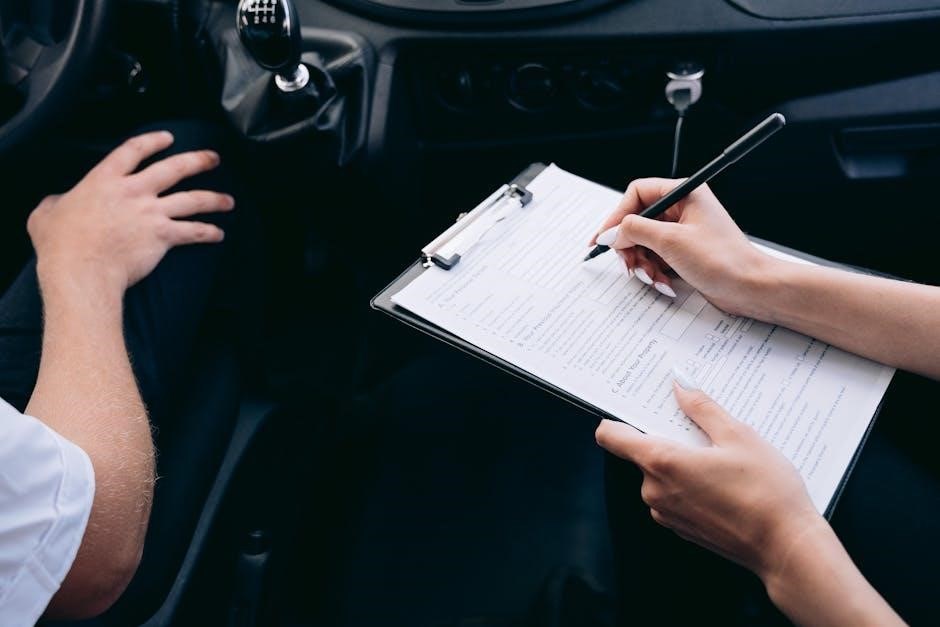Learning to drive a manual transmission offers better control, fuel efficiency, and a deeper connection to driving. While fewer new cars offer manuals, mastering one remains valuable. Start with the right car, like older Japanese models, to ease the learning process and build confidence behind the wheel.
Why Learning to Drive a Manual Car is Beneficial
Learning to drive a manual car offers numerous advantages. It provides better control over the vehicle, allowing drivers to connect more deeply with the road. Manual transmissions often improve fuel efficiency, as drivers can optimize gear shifts. Additionally, cars with manual transmissions are generally more affordable to purchase and maintain. They also tend to have lower insurance costs. Mastering a manual car enhances driving skills and situational awareness, making drivers more adaptable in various conditions. Furthermore, manual cars are less likely to be stolen, as fewer people know how to drive them. Overall, learning manual driving is a valuable skill that combines practicality, cost savings, and a more engaging driving experience.
Key Components of a Manual Transmission Vehicle
A manual transmission vehicle consists of several essential components. The clutch pedal is central, allowing the driver to disconnect the engine from the transmission. The gearshift, located on the center console or floor, is used to select gears. The transmission itself houses the gears that transfer power to the wheels. Hydraulic or cable linkage connects the clutch pedal to the clutch assembly. The flywheel and pressure plate engage the clutch disc when activated. Synchros inside the transmission ensure smooth gear shifts. Finally, the driveshaft transfers power from the transmission to the differential, powering the wheels. Understanding these components helps drivers appreciate how manual cars function and aids in diagnosing issues, making it easier to learn and maintain control while driving.

Factors to Consider When Choosing a Car for Learning Manual
Opt for a car with a smooth clutch and gearbox, low torque, and short gearing. These features make learning easier and reduce the risk of stalling or damage.
Importance of a Smooth Clutch and Gearbox

A smooth clutch and gearbox are essential for learning manual transmission. They allow for easier modulation, reducing the likelihood of stalling and making the learning process less frustrating. A smooth clutch engagement point helps beginners understand when to release the pedal fully, while a seamless gearbox ensures gears transition without grinding. This reduces wear on the transmission and minimizes the risk of costly repairs. Additionally, a smooth setup builds confidence, enabling learners to focus on coordinating clutch and accelerator pedals effectively. Older Japanese models, such as Honda and Toyota, are often praised for their smooth transmissions, making them ideal for novices.
Benefits of Low Torque and Short Gearing
Cars with low torque and short gearing are ideal for learning manual transmission. Low torque reduces the likelihood of wheelspin or abrupt acceleration, making the vehicle more manageable for beginners. Short gearing ensures smoother acceleration from a standstill, allowing learners to practice clutch and accelerator coordination without the car surging forward uncontrollably. This setup minimizes stalling and makes it easier to master the fundamentals of shifting gears. Additionally, short gearing provides better control in low-speed environments, such as parking lots or heavy traffic, where precise movements are crucial; These characteristics are particularly beneficial for new drivers, as they help build confidence and skill in a more forgiving and predictable manner.
Why Older Japanese Models Are Ideal for Beginners
Older Japanese models, such as the Honda Civic, Toyota Corolla, and Mazda MX-5 Miata, are excellent choices for learning manual transmission. These vehicles are known for their smooth, forgiving clutches and precise gearboxes, making it easier for beginners to master shifting without stalling frequently. They also tend to have lower torque outputs, which reduces the risk of wheelspin and loss of control. Additionally, these cars are often more affordable and reliable, with a wide availability of spare parts. Their mechanical simplicity allows new drivers to focus on developing their skills without the distractions or complexities of modern technology. Overall, older Japanese models provide a practical and stress-free environment for learning how to drive a manual car effectively.

Top Cars Recommended for Learning Manual Transmission
- Honda Civic
- Mazda MX-5 Miata
- Toyota Corolla
- BMW M3
- Subaru Impreza
- Scion xB
Beginner-friendly cars include Honda Civic, Mazda MX-5 Miata, Toyota Corolla, BMW M3, Subaru Impreza, and Scion xB. They offer smooth transmissions and reliability, perfect for learning.
Honda Civic: A Classic Choice for Beginners
The Honda Civic is a timeless favorite for learning manual transmission due to its smooth, forgiving clutch and intuitive gearbox. Its lightweight design and responsive acceleration make it easy to handle, especially for new drivers. The Civic’s clutch engagement point is predictable, allowing learners to master shifting without stalling frequently. Additionally, its compact size and excellent visibility simplify maneuvering in tight spaces. Older models, particularly from the 90s and early 2000s, are highly recommended for their simplicity and reliability. The Civic’s affordability and widespread availability further enhance its appeal as a beginner-friendly car. With a strong community of enthusiasts and ample resources, the Honda Civic remains a top choice for mastering manual transmission.
Mazda MX-5 Miata: A Roadster with an Easy Clutch
The Mazda MX-5 Miata stands out as a roadster with a remarkably smooth and forgiving clutch, making it an excellent choice for learners. Its lightweight design and balanced handling provide a responsive driving experience, allowing new drivers to feel connected to the road. The short-throw gearbox and well-defined clutch engagement point help reduce stalling and make shifting gears intuitive. Despite its sporty nature, the Miata’s predictable behavior and manageable power output create a stress-free learning environment. Its popularity among driving enthusiasts ensures a wealth of resources and support for those mastering manual transmission. The MX-5 Miata is not only fun to drive but also an ideal platform for building confidence and skill behind the wheel.
Toyota Corolla: Reliability and Simplicity
The Toyota Corolla is a top choice for learning manual transmission due to its reputation for reliability and simplicity. Known for its smooth clutch engagement and manageable power delivery, the Corolla makes the learning process less intimidating. Its lightweight design and straightforward gearbox ensure that new drivers can focus on mastering clutch control and gear shifting without unnecessary complexity. Older models, in particular, are ideal for beginners, as they are abundant, affordable, and easy to maintain. The Corolla’s predictable behavior and forgiving nature reduce the likelihood of stalling, allowing learners to build confidence and skill efficiently. Its combination of practicality and ease of use makes it a standout option for anyone looking to learn manual transmission.
BMW M3: A Performance Car with a Manual Option
The BMW M3 stands out as a high-performance vehicle that still offers a manual transmission, appealing to driving enthusiasts. Unlike most modern performance cars, the M3 retains a six-speed manual option, preserving the tactile connection between driver and machine. Its precise shifter and clutch mechanism make it a joy to drive, though it may require more skill and coordination compared to simpler models. While it’s more powerful, the M3’s responsive handling and predictable behavior can actually aid in learning advanced driving techniques. However, its higher cost and performance-oriented nature make it less practical for beginners. Still, for those aiming to master manual driving, the M3 provides an exhilarating experience that combines power with precision.
Subaru Impreza: All-Wheel Drive and Manual Transmission
The Subaru Impreza is a standout choice for learning manual transmission, offering a unique blend of all-wheel drive and a smooth-shifting gearbox. Its symmetrical all-wheel-drive system provides excellent traction, making it easier to handle, especially in slippery conditions. The Impreza’s manual transmission is known for its light clutch and precise shifting, reducing the learning curve for beginners. Its compact size and responsive steering also make it easy to maneuver. While not the cheapest option, the Impreza’s reliability and practicality make it a great choice for everyday driving. The combination of its engaging driving dynamics and all-weather capability creates a versatile car for both learning and long-term ownership.
Scion xB: Affordable and Easy to Handle
The Scion xB is an excellent choice for learning manual transmission due to its affordability and ease of handling. Its compact design and lightweight structure make it highly maneuverable, perfect for new drivers. The xB’s manual gearbox is smooth and forgiving, with a clutch that’s easy to modulate, reducing the risk of stalling. The car’s low torque and short gearing also make it ideal for city driving, where frequent shifting is common. Additionally, the xB’s boxy shape provides excellent visibility, boosting confidence for learners. Its budget-friendly price and reliable performance make it a practical option for those looking to master manual driving without breaking the bank. The Scion xB strikes a balance between simplicity and functionality, making it a great starting point for new drivers.

Tips for Learning to Drive a Manual Car
Start in a flat, open space to practice clutch control and shifting gears smoothly. Focus on feeling the clutch engagement point and avoid riding the clutch to prevent wear.
Mastering the Clutch-Engagement Point
Mastering the clutch-engagement point is crucial for smooth manual driving. Begin by finding the “biting point,” where the engine begins to engage with the transmission. Practice in a flat area, shifting through gears while paying attention to the vehicle’s response. Start in first gear, pressing the clutch fully down, then slowly release while accelerating. Repeat this process to build muscle memory. Avoid sudden movements, as they can cause the car to stall or jerk. Consistent practice helps develop a smooth transition, essential for controlling the vehicle effectively. This skill is foundational for all manual driving techniques, ensuring a seamless connection between driver and car.
Practicing in a Safe and Open Environment
Practicing in a safe and open environment is essential for learning manual transmission. Choose an empty parking lot or a quiet, open space with minimal obstacles. Start by familiarizing yourself with basic operations like stopping, starting, and shifting gears without pressure. Focus on controlling the car’s speed and maintaining awareness of your surroundings. Avoid high-traffic areas to minimize stress and distractions. Begin with slow, deliberate movements, gradually increasing your speed as confidence grows. Practicing stalling and recovering is part of the process, so don’t be discouraged. Having a patient instructor or guide can provide valuable feedback and help you improve faster. Consistent practice in a stress-free setting builds the skills and confidence needed to master manual driving effectively.

Common Mistakes to Avoid When Learning Manual
Common mistakes include riding the clutch, which wears the transmission, and forgetting to press the clutch when shifting, causing grinding gears. Avoid these to prevent damage and ensure smooth learning.
Riding the Clutch and Wearing Out the Transmission
Riding the clutch, or keeping it partially pressed, is a common mistake that can significantly wear out the transmission. This habit causes excessive friction between the clutch disc and flywheel, leading to premature wear. Over time, this can result in costly repairs. To avoid this, drivers should fully release the clutch pedal once the car is moving. Additionally, avoiding riding the clutch on hills or in traffic is crucial. Practicing proper clutch engagement and disengagement techniques helps develop good driving habits. By being mindful of clutch usage, learners can extend the life of their transmission and ensure smoother gear shifts. This is especially important when learning in a car designed for manual transmission, as it preserves the vehicle’s longevity.
Forgetting to Press the Clutch When Shifting
Forgetting to press the clutch pedal when shifting gears is a common mistake among learners. This oversight can lead to grinding gears, difficulty shifting, or even damage to the transmission. Always ensure the clutch is fully pressed before attempting to shift gears. This prevents the gears from clashing and reduces wear on the transmission components. Developing a consistent shifting process helps build muscle memory, reducing the likelihood of this error. Practicing in a safe, stationary environment can help learners get accustomed to the proper sequence of actions. Over time, this becomes second nature, making manual driving smoother and more enjoyable. Consistency is key to mastering this fundamental skill.
Choosing the right car is crucial for mastering manual transmission. Models like the Honda Civic, Mazda MX-5 Miata, Toyota Corolla, BMW M3, Subaru Impreza, and Scion xB are ideal due to their smooth clutch engagement, forgiving gearing, and reliability. These vehicles offer a perfect balance of simplicity and responsiveness, making the learning process less intimidating; Older Japanese models, in particular, are praised for their straightforward mechanics and ease of use. By selecting one of these cars, learners can focus on developing proper techniques without the added stress of complicated systems. With patience and practice, mastering manual transmission becomes an enjoyable and rewarding experience that enhances driving skills and connection to the road.